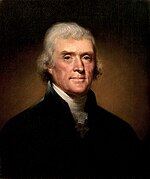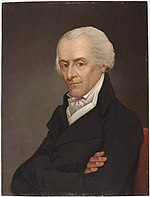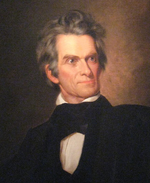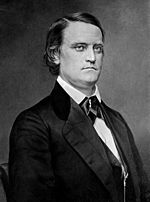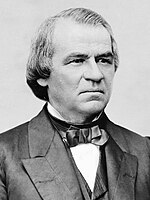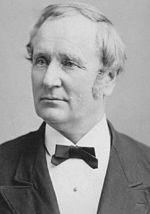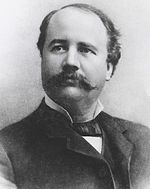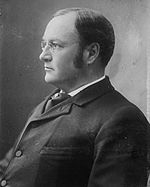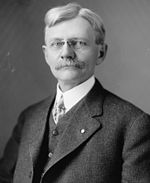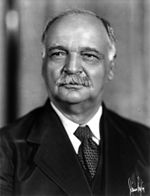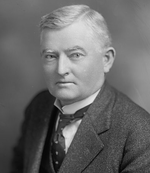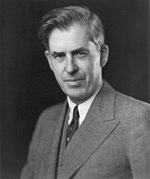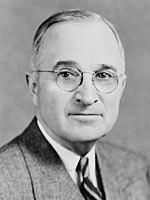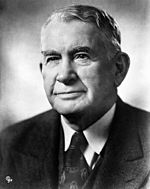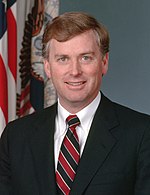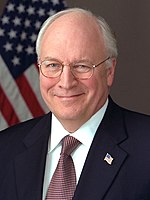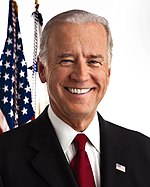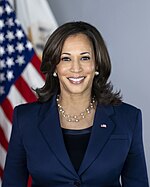
George Herbert Walker Bush was an American politician, diplomat, and businessman who served as the 41st president of the United States from 1989 to 1993. A member of the Republican Party, he also served as the 43rd vice president from 1981 to 1989 under Ronald Reagan, and in various other federal positions prior to that.

The president of the United States (POTUS) is the head of state and head of government of the United States of America. The president directs the executive branch of the federal government and is the commander-in-chief of the United States Armed Forces.
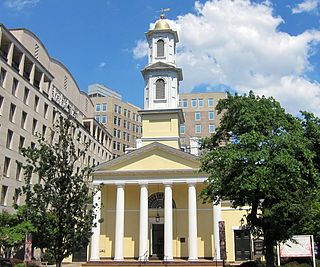
Religious affiliations can affect the electability of the presidents of the United States and shape their stances on policy matters and their visions of society and also how they want to lead it. While no president has ever openly identified as an atheist, Thomas Jefferson, Abraham Lincoln, and William Howard Taft were speculated to be atheists by their opponents during political campaigns; in addition, a survey during the presidency of Donald Trump showed that 63% of Americans did not believe he was religious, despite his professed Christian affiliation. Trump supporters have also circulated conspiracy theories that Barack Obama is a Muslim. Conversely, other presidents, such as Jimmy Carter, have used their faith as a defining aspect of their campaigns and tenure in office.

The vice president of the United States (VPOTUS) is the second-highest officer in the executive branch of the U.S. federal government, after the president of the United States, and ranks first in the presidential line of succession. The vice president is also an officer in the legislative branch, as the president of the Senate. In this capacity, the vice president is empowered to preside over the United States Senate, but may not vote except to cast a tie-breaking vote. The vice president is indirectly elected together with the president to a four-year term of office by the people of the United States through the Electoral College. Since the passage of the Twenty-fifth Amendment to the US Constitution, the vice president may also be appointed by the president to fill a vacancy, via majority confirmation by both the Senate and the House.

The Twenty-second Amendment to the United States Constitution limits the number of times a person can be elected to the office of President of the United States to two terms, and sets additional eligibility conditions for presidents who succeed to the unexpired terms of their predecessors. Congress approved the Twenty-second Amendment on March 21, 1947, and submitted it to the state legislatures for ratification. That process was completed on February 27, 1951, when the requisite 36 of the 48 states had ratified the amendment, and its provisions came into force on that date.

The United States presidential line of succession is the order in which the vice president of the United States and other officers of the United States federal government assume the powers and duties of the U.S. presidency upon an elected president's death, resignation, removal from office, or incapacity.

The fireside chats were a series of evening radio addresses given by Franklin D. Roosevelt, the 32nd President of the United States, between 1933 and 1944. Roosevelt spoke with familiarity to millions of Americans about recovery from the Great Depression, the promulgation of the Emergency Banking Act in response to the banking crisis, the 1936 recession, New Deal initiatives, and the course of World War II. On radio, he quelled rumors, countered conservative-dominated newspapers, and explained his policies directly to the American people. His tone and demeanor communicated self-assurance during times of despair and uncertainty. Roosevelt was regarded as an effective communicator on radio, and the fireside chats kept him in high public regard throughout his presidency. Their introduction was later described as a "revolutionary experiment with a nascent media platform."

Larry Joseph Sabato is an American political scientist and political analyst. He is the Robert Kent Gooch Professor of Politics at the University of Virginia, where he is also the founder and director of the Center for Politics, which works to promote civic engagement and participation. The Center for Politics is also responsible for the publication of Sabato's Crystal Ball, an online newsletter and website that provides free political analysis and electoral projections.

Gerald Rudolph Ford Jr. was an American politician who served as the 38th president of the United States from 1974 to 1977. He previously served as the leader of the Republican Party in the U.S. House of Representatives from 1965 to 1973, and as the 40th vice president under President Richard Nixon from 1973 to 1974. Ford succeeded to the presidency when Nixon resigned in 1974, but was defeated for election to a full term in 1976. Ford is the only person to serve as president and vice president without being elected to either office.

The presidency of John Adams, began on March 4, 1797, when John Adams was inaugurated as the second president of the United States, and ended on March 4, 1801. Adams, who had served as vice president under George Washington, took office as president after winning the 1796 presidential election. The only member of the Federalist Party to ever serve as president, his presidency ended after a single term following his defeat in the 1800 presidential election. He was succeeded by Thomas Jefferson of the opposition Democratic-Republican Party.

The 1999 State of the Union Address was given by the 42nd president of the United States, Bill Clinton, on January 19, 1999, at 9:00 p.m. EST, in the chamber of the United States House of Representatives to the 106th United States Congress. It was Clinton's sixth State of the Union Address and his seventh speech to a joint session of the United States Congress. Presiding over this joint session was the House speaker, Dennis Hastert, accompanied by Al Gore, the vice president, in his capacity as the president of the Senate.
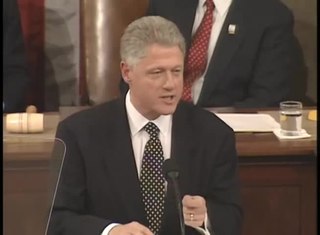
The 1998 State of the Union Address was given by the 42nd president of the United States, Bill Clinton, on January 27, 1998, at 9:00 p.m. EST, in the chamber of the United States House of Representatives to the 105th United States Congress. It was Clinton's fifth State of the Union Address and his sixth speech to a joint session of the United States Congress. Presiding over this joint session was the House speaker, Newt Gingrich, accompanied by Al Gore, the vice president, in his capacity as the president of the Senate.

The 1996 State of the Union Address was given by the 42nd president of the United States, Bill Clinton, on January 23, 1996, at 9:00 p.m. EST, in the chamber of the United States House of Representatives to the 104th United States Congress. It was Clinton's third State of the Union Address and his fourth speech to a joint session of the United States Congress. Presiding over this joint session was the House speaker, Newt Gingrich, accompanied by Al Gore, the vice president, in his capacity as the president of the Senate.
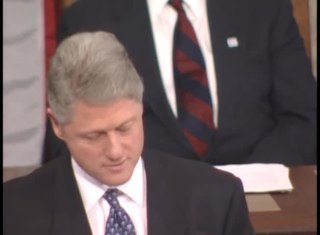
The 1995 State of the Union Address was given by the 42nd president of the United States, Bill Clinton, on January 24, 1995, at 9:00 p.m. EST, in the chamber of the United States House of Representatives to the 104th United States Congress. It was Clinton's second State of the Union Address and his third speech to a joint session of the United States Congress. Presiding over this joint session was the House speaker, Newt Gingrich, accompanied by Al Gore, the vice president, in his capacity as the president of the Senate.

The 1994 State of the Union Address was given by the 42nd president of the United States, Bill Clinton, on January 25, 1994, at 9:00 p.m. EST, in the chamber of the United States House of Representatives to the 103rd United States Congress. It was Clinton's first State of the Union Address and his second speech to a joint session of the United States Congress. Presiding over this joint session was House speaker Tom Foley, accompanied by Vice President Al Gore, in his capacity as the president of the Senate.
The 1991 State of the Union Address was given by the 41st president of the United States, George H. W. Bush, on January 29, 1991, at 9:00 p.m. EST, in the chamber of the United States House of Representatives to the 102nd United States Congress. It was Bush's second State of the Union Address and his third speech to a joint session of the United States Congress. Presiding over this joint session was the House speaker, Tom Foley, accompanied by Dan Quayle, the vice president, in his capacity as the president of the Senate.

The 1990 State of the Union Address was given by the 41st president of the United States, George H. W. Bush, on January 31, 1990, at 9:00 p.m. EST, in the chamber of the United States House of Representatives to the 101st United States Congress. It was Bush's first State of the Union Address and his second speech to a joint session of the United States Congress. Presiding over this joint session was the House speaker, Tom Foley, accompanied by Dan Quayle, the vice president, in his capacity as the president of the Senate.

The United States elections of 1788–1789 were the first federal elections in the United States following the ratification of the United States Constitution in 1788. In the elections, George Washington was elected as the first president and the members of the 1st United States Congress were selected.


